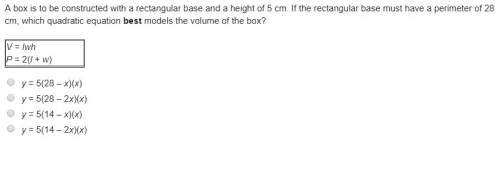
Mathematics, 04.03.2021 19:20 RealSavage4Life
Solve a triangle with a =5, b=6, and c= 7. Round to the nearest tenth.

Answers: 1


Other questions on the subject: Mathematics


Mathematics, 21.06.2019 23:00, nataliemakin7123
Which rectangle if translated 6 units right and 16 units down and the rotated 90° clockwise about the point (4, -11) will result in rectangle e?
Answers: 2

Mathematics, 22.06.2019 00:20, ashtonviceoxd21i
Submarines control how much they float or sink in the ocean by changing the volume of air and water contained in large ballast tanks. when the tanks are completely full of water, the submarine increases its overall mass and sinks down to the bottom. when the tanks are completely full of air, the submarine reduces its overall mass and floats to the surface. depending on the density of the seawater surrounding the submarine, it will pump seawater in or out of the tanks in order to achieve the same overall density as the sea water and float neutrally in the water. the volume of the submarine never changes. when the tanks are completely full of water, a submarine with a volume of 7.8\times10^3\text{ m}^37.8×10 3 m 3 7, point, 8, times, 10, start superscript, 3, end superscript, space, m, start superscript, 3, end superscript has a total mass of 8\times10^6\text{ kg}8×10 6 kg8, times, 10, start superscript, 6, end superscript, space, k, g. the density of the seawater is 10^3\text{ kg/m}^310 3 kg/m 3 10, start superscript, 3, end superscript, space, k, g, slash, m, start superscript, 3, end superscript. to make that submarine float neutrally, and neither float nor sink in the ocean, what volume of water does that submarine need to subtract from its tanks?
Answers: 1

Mathematics, 22.06.2019 03:00, TheOriginalMeyah
The biologist has a second culture to examine. she knows that the population of the culture doubles every 15 minutes. after 1 hour and 15 minutes, her assistant found that 80,000 bacteria were present. a) what was the size of the initial population? b) predict the size of the culture at t=3 hours. what was the size of the population at 40 minutes? explain and justify your answers. c) create a graph of the population as a function of time. find an equation that can be used to predict the size of the population at any time t. d) examine the rate at which the bacteria culture is growing. how fast is the culture growing after 1 hour? after 1.5 hours? after 2 hours? use a time interval of h = 0.01 hours to estimate these rates. interpret these rates in terms of the context of the problem situation. how do these three rates compare?
Answers: 1
You know the right answer?
Solve a triangle with a =5, b=6, and c= 7. Round to the nearest tenth....
Questions in other subjects:

History, 12.11.2019 04:31

Mathematics, 12.11.2019 04:31

Health, 12.11.2019 04:31

Mathematics, 12.11.2019 04:31




Mathematics, 12.11.2019 04:31

Mathematics, 12.11.2019 04:31





